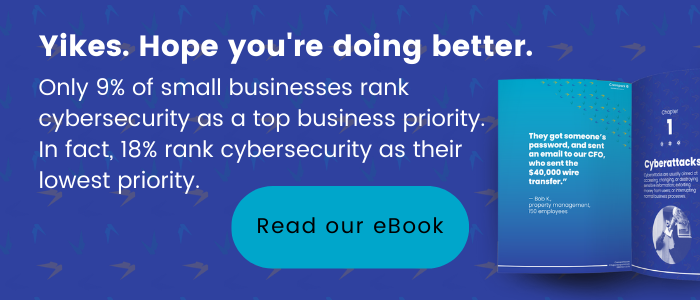Data Analytics | Better Understanding Cybersecurity
A few months ago, you were worrying about your home’s security and finally bought one of those front-door cameras that connect to your phone through an app. Typically, you only receive a few notifications a day, usually when you or your family enter or exit the house. But recently, you’ve been getting way more notifications. You decide to investigate just to make sure everything is okay.
Congratulations, you just used data analytics!
Analytics help humans identify key observable information to help better their decision-making in a variety of environments. This is prevalent in all aspects of business, but Cybersecurity —a field that’s ever-changing due to the emergence of new cyberattacks every day—relies heavily on analytics.
Cybersecurity uses analytics to identify unusual behavior and prompt people to investigate potential threats to their network, ultimately better protecting their organization. These types of analytics, referred to as cybersecurity-based analytics, are integral for maintaining the integrity of a secure organizational network.
In this article, we’ll guide you through data analytics to help you better understand how your organization’s cybersecurity network works.
What is data analytics?
Data analytics is the science of analyzing raw data to make conclusions about the information. We must use effective data collection processes to achieve efficient data analysis. Thankfully, most of this has the potential to be automated (to help us stay sane). Dealing with potentially hundreds of thousands of data points is not the most productive way for us to spend our workdays. Let’s use our brains for things that matter, so instead, let’s concern ourselves with checking the validity of a statistical conclusion made about the data, and if there are any causes for concerns, taking any appropriate action.
There are four different types of data analytics:
1. Descriptive analytics
Data used to describe a trend of data over a period of time
Ex. The number of apples grown has increased year over year in the last decade.
2. Diagnostic analytics
Data used to describe why something occurred (AKA post-occurrence analysis)
Ex. The number of apples grown year over year has increased due to the increase in apple farmers.
3. Predictive analytics
Data used to predict the future behavior of the likeliness of a future outcome in a particular process.
Ex. The number of apples grown year over year should continue to increase as there is an indication the number of apple farmers will continue to increase over the next two years.
4. Prescriptive analytics
Data used to suggest the direction you should take next.
Ex. The increase in the number of apples grown year over year suggests we should invest in the apple industry.
Descriptive analytics
Descriptive analytics can be defined as the process of using data analytics of current and historical data to discover trends and relationships between designated factors. This can be as simple as creating a line graph with an axis for sales and time to visualize the change in sales over an extended period of time. These types of analytics are considered the most simple and are used most commonly for financial reporting. Examples of this could be yearly sales growth or the number of products sold monthly.
Diagnostic analytics
Diagnostic analytics is a complex form of analytics created with the goal of defining why something happened. Often times when dealing with this type of analytics, you will hear terms such as drilling-down, data discovery, and data mining. These processes are generally automated through programs. The gist of all complex processes is that they are concerned with finding deeper trends between data and then validating the conclusions with the data.
Prescriptive analytics
Prescriptive analytics is the use of data to determine an ideal course of action. This type of analytics is done by relying on machine learning and artificial intelligence to compute and understand complex data. The harsh reality is humans do not have the capability or time to review millions or even billions of data points, and thus we must rely on computer programs and their strong computational power to quicken this process of data analysis. Oftentimes, prescriptive analytics is used in conjunction with predictive analytics, which will be discussed more in-depth below.
Predictive analytics
Predictive analytics is arguably the most important type of analytics when it comes to cybersecurity. The entire concept of cybersecurity is built on the idea that the best way to prevent cyberattacks is before they even happen. This is why predictive analytics is so important; they allow organizations to be able to predict major flaws in their security so that they can take preemptive action against future cybersecurity attacks. An example of this would be organizations needing to be able to predict which devices are at risk in your organization so that they can take preventative measures to ensure the safety of their data.
You do this by taking separate data points and finding hidden relationships between them, allowing you to conclude about the state of your cybersecurity. An example would be finding out if there is a relationship between the number of devices in your organization that has access to your network and the user behavior data. User behavior data is basically quantifying and ultimately finding patterns when users access their network, such as their typical log-in location. Once a relationship is determined, it is up to you to decide what this means for the security of your network and what the next steps are.
There are three main pros to using predictive analytics:
- Influences a proactive approach to security which is the industry standard
- Tools that deal with predictive analytics automate most of the workload
- The tools dealing with predictive analytics can handle and analyze large influxes of data
A tool’s ability to handle large influxes of data is essential when dealing with big data. Big data describes large, hard-to-deal-with volumes of data. This could be large amounts of data logs, or event data from all of the network devices and applications in your organization.
Real-time threat detection
If you’re concerned with your organization’s cybersecurity, you have two main priorities. One, to prevent any security breaches, and two, if a breach occurs, detect it as soon as possible to minimize damages. Real-time threat detection is the process of capturing real-time signals from various sources to leverage data providing your company with situational awareness, and ultimately helping you detect potential security breaches as soon as possible.
Real-time threat detection is broken down into three concepts:
- Prevention
- How do you prevent a Cybersecurity attack?
- Detection
-
- If you didn’t prevent this attack, how do you detect it as soon as possible?
- Recovery
-
- If the previous two aspects were overlooked, how do you mitigate the least amount of damage to your data?
To put these concepts into action, you must focus on ensuring your organization is equipped with the right technology, your employees are properly educated on cybersecurity risks, and your network has the right policies in place to defend/recover from a cyberattack. Start by asking yourself these three questions:
- Technology
-
- How do you collect data and monitor user behavior?
- Education
-
- 90% of cyberattacks use social engineering—are your employees educated with the right tools to protect themselves?
- Policy
-
- What is your network’s security framework? Does it allow you to easily track and detect cyberattacks?
Securing your front door
In the rapidly-developing digital world, it’s vital to stay on top of current threats, cybersecurity trends, and best practices to best protect your organization. None of this would be possible without relying on and understanding data analytics. Just like your front-door security camera, your organization needs the correct tools to identify potential threats. Now that you know, you can equip your organization with the best front-door security for your network. To learn more about your organization’s digital health risks, read our free security eBook today!
Related Posts
Subscribe our newsletter
Enter your email to get latest updates.

















